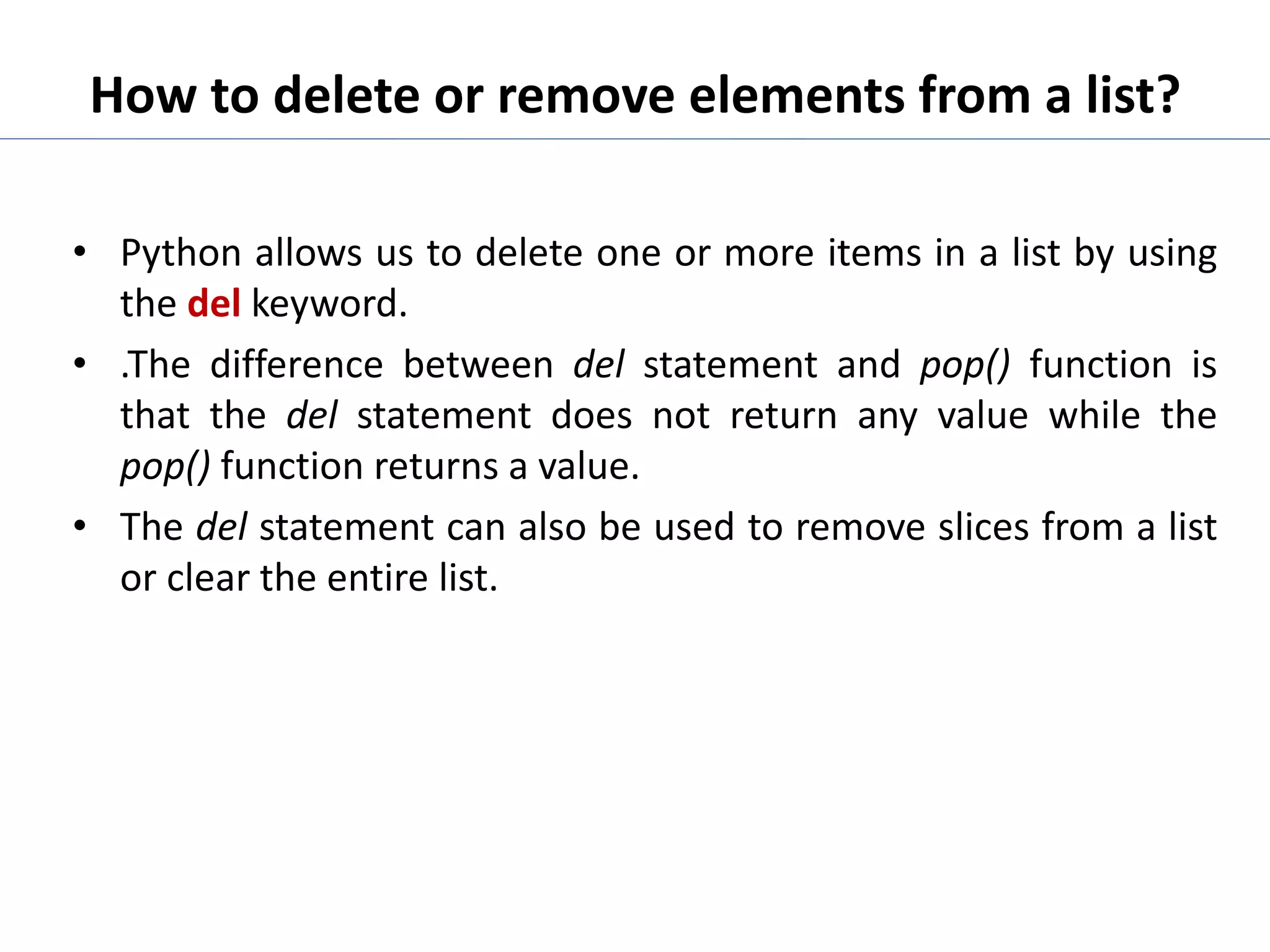The document discusses lists in Python. It defines lists as collections of values separated by commas and enclosed in square brackets. It provides examples of creating lists and performing common operations like concatenation, repetition, slicing, membership testing, indexing, updating/changing elements, and built-in functions/methods like len(), min(), max(), sort(), and reverse(). The document also covers iterating through lists using for loops and deleting elements using the del statement.

![List in Python
• In python, a list can be defined as a collection of values or
items.
• The items in the list are separated with the comma (,) and
enclosed with the square brackets [ ].
Syntax:
list_name= [ item1, item2,item3…. ]
Example: “listdemo.py”
L1 = []
L2 = [123,"python", 3.7]
L3 = [1, 2, 3, 4, 5, 6]
L4 = ["C","Java","Python"]
print(L1)
print(L2)
print(L3)
print(L4)
Output:
python listdemo.py
[]
[123, 'python', 3.7]
[1, 2, 3, 4, 5, 6]
['C','Java','Python']](https://image.slidesharecdn.com/updatedlist-230126102647-ba899e59/75/updated_list-pptx-2-2048.jpg)

![List Operators in Python
+
It is known as concatenation operator used to concatenate two
lists.
*
It is known as repetition operator. It concatenates the multiple
copies of the same list.
[]
It is known as slice operator. It is used to access the list item
from list.
[:]
It is known as range slice operator. It is used to access the range
of list items from list.
in
It is known as membership operator. It returns if a particular
item is present in the specified list.
not in
It is also a membership operator and It returns true if a
particular list item is not present in the list.](https://image.slidesharecdn.com/updatedlist-230126102647-ba899e59/75/updated_list-pptx-4-2048.jpg)
![List Operators in Python cont…
Example: “listopdemo.py”
num=[1,2,3,4,5]
lang=['python','c','java','php']
print(num + lang) #concatenates two lists
print(num * 2) #concatenates same list 2 times
print(lang[2]) # prints 2nd index value
print(lang[1:4]) #prints values from 1st to 3rd index.
print('cpp' in lang) # prints False
print(6 not in num) # prints True
Output: python listopdemo.py
[1, 2, 3, 4, 5, 'python', 'c', 'java', 'php']
[1, 2, 3, 4, 5, 1, 2, 3, 4, 5]
java
['c', 'java', 'php']
False
True](https://image.slidesharecdn.com/updatedlist-230126102647-ba899e59/75/updated_list-pptx-5-2048.jpg)

![List Indexing in Python
• Like string sequence, the indexing of the python lists starts from 0,
i.e. the first element of the list is stored at the 0th index, the second
element of the list is stored at the 1st index, and so on.
• The elements of the list can be accessed by using the slice operator
[].
• The syntax for accessing an item in a list is,
• list_name[index]
Example:
mylist=[‘banana’,’apple’,’mango’,’tomato’,’berry’]
• mylist[0]=”banana” mylist[1:3]=[”apple”,”mango”]
• mylist[2]=”mango”](https://image.slidesharecdn.com/updatedlist-230126102647-ba899e59/75/updated_list-pptx-7-2048.jpg)
![List Indexing in Python cont…
• Unlike other languages, python provides us the flexibility to use
the negative indexing also. The negative indices are counted
from the right.
• The last element (right most) of the list has the index -1, its
adjacent left element is present at the index -2 and so on until
the left most element is encountered.
Example: mylist=[‘banana’,’apple’,’mango’,’tomato’,’berry’]
• mylist[-1]=”berry” mylist[-4:-2]=[“apple”,mango”]
• mylist[-3]=”mango” mvlist[ -3 : ]=[“mango”,”tomato”,’berry’]](https://image.slidesharecdn.com/updatedlist-230126102647-ba899e59/75/updated_list-pptx-8-2048.jpg)

![• 1. >>> fruits = ["grapefruit", "pineapple", "blueberries", "mango",
"banana"]
• 2. >>> fruits[1:3]
• ['pineapple', 'blueberries']
• 3. >>> fruits[:3]
• ['grapefruit', 'pineapple', 'blueberries']
• 4. >>> fruits[2:]
• ['blueberries', 'mango', 'banana']
• 5. >>> fruits[1:4:2]
• ['pineapple', 'mango']
• 6. >>> fruits[:]
• ['grapefruit', 'pineapple', 'blueberries', 'mango', 'banana']
• 7. >>> fruits[::2]
• ['grapefruit', 'blueberries', 'banana']
• 8. >>> fruits[::-1]
• ['banana', 'mango', 'blueberries', 'pineapple', 'grapefruit']
• 9. >>> fruits[-3:-1]
• ['blueberries', 'mango']](https://image.slidesharecdn.com/updatedlist-230126102647-ba899e59/75/updated_list-pptx-10-2048.jpg)
![How to update or change elements to a list?
• Python allows us to modify the list items by using the slice and
assignment operator.
• We can use assignment operator ( = ) to change an item or a
range of items.
Example: “listopdemo1.py”
num=[1,2,3,4,5]
print(num)
num[2]=30
print(num)
num[1:3]=[25,36]
print(num)
num[4]="Python"
print(num)
List1=num1
Print(list1)
Output:
python listopdemo1.py
[1, 2, 3, 4, 5]
[1, 2, 30, 4, 5]
[1, 25, 36, 4, 5]
[1, 25, 36, 4, 'Python']
[1, 25, 36, 4, ‘python’]](https://image.slidesharecdn.com/updatedlist-230126102647-ba899e59/75/updated_list-pptx-11-2048.jpg)

![List Functions & Methods in Python
• Python provides various in-built functions .Those are
☞ len():
• In Python, len() function is used to find the length of list,i.e it
returns the number of items in the list..
Syntax: len(list)
• len()
• any()
• all()
• sum()
• sorted()
Example: listlendemo.py
num=[1,2,3,4,5,6]
print("length of list :",len(num))
Output:
python listlendemo.py
length of list : 6](https://image.slidesharecdn.com/updatedlist-230126102647-ba899e59/75/updated_list-pptx-13-2048.jpg)
![• ☞ any():
• The any() function returns True if any of the Boolean
values in the list is True.
• Syntax: any(iterable)
• Iterable: It is an iterable object such as a dictionary,
tuple, list, set, etc.
• Ex:
• any([1, 1, 0, 0, 1, 0])
• True
• any(0,0,0,0)
• False
• list2=[1,0,2]
• any(list2)
• True](https://image.slidesharecdn.com/updatedlist-230126102647-ba899e59/75/updated_list-pptx-14-2048.jpg)
![• ☞ all():
• The all() function returns True if all the Boolean values in the
list are True, else returns False.
• Syntax: any(iterable)
• Iterable: It is an iterable object such as a dictionary, tuple, list,
set, etc.
• Ex:
• >>> all([1, 1, 1, 1])
• True
• >>> all([1,0,2])
• False
• >>> all([1,2,3,4,5,])
• True](https://image.slidesharecdn.com/updatedlist-230126102647-ba899e59/75/updated_list-pptx-15-2048.jpg)
![List Functions in Python Cont..
☞ sum ():
• In python, sum() function returns sum of all values in the list. List
values must in number type.
Syntax: sum(list)
Example: listsumdemo.py
list1=[1,2,3,4,5,6]
print("Sum of list items :",sum(list1))
Output:
python listsumdemo.py
Sum of list items : 21](https://image.slidesharecdn.com/updatedlist-230126102647-ba899e59/75/updated_list-pptx-16-2048.jpg)
![List Functions in Python Cont..
☞ sorted ():
• The sorted() function returns a modified copy of the list while
leaving the original list untouched.
Syntax: sorted(list)
Example: sorteddemo.py
num=[23,5,78,9]
print(sorted(num))
[5, 9, 23, 78]
print(num)
[23, 5, 78, 9]](https://image.slidesharecdn.com/updatedlist-230126102647-ba899e59/75/updated_list-pptx-17-2048.jpg)


![List Methods in Python Cont..
☞ max ():
• In Python, max() function is used to find maximum value in the list.
Syntax: max(list)
Example: listmaxdemo.py
list1=[1,2,3,4,5,6]
list2=['java','c','python','cpp']
print("Max of list1 :",max(list1))
print("Max of list2 :",max(list2))
Output:
python listmaxdemo.py
Max of list1 : 6
Max of list2 : python](https://image.slidesharecdn.com/updatedlist-230126102647-ba899e59/75/updated_list-pptx-20-2048.jpg)
![List Methods in Python Cont..
☞ min ():
• In Python, min() function is used to find minimum value in the list.
Syntax: min(list)
Example: listmindemo.py
list1=[1,2,3,4,5,6]
list2=['java','c','python','cpp']
print("Min of list1 :",min(list1))
print("Min of list2 :",min(list2))
Output:
python listmindemo.py
Min of list1 : 1
Min of list2 : c](https://image.slidesharecdn.com/updatedlist-230126102647-ba899e59/75/updated_list-pptx-21-2048.jpg)
![List Methods in Python Cont..
☞ list ():
• In python, list() is used to convert given sequence (string or tuple)
into list.
Syntax: list(sequence)
Example: listdemo.py
str="python"
list1=list(str)
print(list1)
Output:
python listdemo.py
['p', 'y', 't', 'h', 'o', 'n']](https://image.slidesharecdn.com/updatedlist-230126102647-ba899e59/75/updated_list-pptx-22-2048.jpg)
![List Methods in Python Cont..
☞ append ():
The append() method adds a single item to the end of the list. This
method does not return new list and it just modifies the original.
Syntax: list.append(item)
where item may be number, string, list and etc.
Example: num=[1,2,3,4,5]
lang=['python','java']
num.append(6)
print(num)
lang.append("cpp")
print(lang)
list=[1,2,3,4]
list.append([6,7])
print(list)
Output:
python appenddemo.py
[1, 2, 3, 4, 5, 6]
['python', 'java', 'cpp']
[1, 2, 3, 4, [6, 7]]](https://image.slidesharecdn.com/updatedlist-230126102647-ba899e59/75/updated_list-pptx-23-2048.jpg)
![List Methods in Python Cont..
☞ remove ():
• In python, remove() method removes item from the list. It removes
first occurrence of item if list contains duplicate items. It throws an
“value error” if the item is not present in the list.
Syntax: list.remove(item)
Example: removedemo.py
list1=[1,2,3,4,5]
list2=['A','B','C','B','D']
list1.remove(2)
print(list1)
list2.remove("B")
print(list2)
list2.remove("E")
print(list2)
Output:
python removedemo.py
[1, 3, 4, 5]
['A', 'C', 'B', 'D']
ValueError: x not in list](https://image.slidesharecdn.com/updatedlist-230126102647-ba899e59/75/updated_list-pptx-24-2048.jpg)
![List Methods in Python Cont..
☞ sort ():
• In python, sort() method sorts the list elements into descending or
ascending order. By default, list sorts the elements into ascending
order. It takes an optional parameter 'reverse' which sorts the list
into descending order. This method modifies the original list.
Syntax: list.sort()
Example: sortdemo.py
list1=[6,8,2,4,10]
list1.sort()
print("n After Sorting:n")
print(list1)
print("Descending Order:n")
list1.sort(reverse=True)
print(list1)
Output:
python sortdemo.py
After Sorting:
[2, 4, 6, 8 , 10]
Descending Order:
[10, 8, 6, 4 , 2]](https://image.slidesharecdn.com/updatedlist-230126102647-ba899e59/75/updated_list-pptx-25-2048.jpg)
![List Methods in Python Cont..
☞ reverse ():
• In python, reverse() method reverses elements of the list. i.e. the
last index value of the list will be present at 0th index. This method
modifies the original list and it does not return a new list.
Syntax: list.reverse()
Example: reversedemo.py
list1=[6,8,2,4,10]
list1.reverse()
print("n After reverse:n")
print(list1)
Output:
python reversedemo.py
After reverse:
[10, 4, 2, 8 , 6]](https://image.slidesharecdn.com/updatedlist-230126102647-ba899e59/75/updated_list-pptx-26-2048.jpg)
![List Methods in Python Cont..
☞ count():
• In python, count() method returns the number of times an element
appears in the list. If the element is not present in the list, it
returns 0.
Syntax: list.count(item)
Example: countdemo.py
num=[1,2,3,4,3,2,2,1,4,5,8]
cnt=num.count(2)
print("Count of 2 is:",cnt)
cnt=num.count(10)
print("Count of 10 is:",cnt) Output:
python countdemo.py
Count of 2 is: 3
Count of 10 is: 0](https://image.slidesharecdn.com/updatedlist-230126102647-ba899e59/75/updated_list-pptx-27-2048.jpg)
![List Methods in Python Cont..
☞ index():
• In python, index () method returns index of the passed element. If
the element is not present, it raises a ValueError.
• If list contains duplicate elements, it returns index of first
occurred element.
• This method takes two more optional parameters start and end
which are used to search index within a limit.
Syntax: list. index(item [, start[, end]])
Example: indexdemo.py
list1=['p','y','t','o','n','p']
print(list1.index('t'))
Print(list1.index('p'))
Print(list1.index('p',3,10))
Print(list1.index('z')) )
Output:
python indexdemo.py
2
0
5
Value Error](https://image.slidesharecdn.com/updatedlist-230126102647-ba899e59/75/updated_list-pptx-28-2048.jpg)
![List Methods in Python Cont..
☞ insert():
• In python, the insert() method inserts the item at the given index,
shifting items to the right.
Syntax: list.insert(index,item)
Example: insertdemo.py
num=[10,20,30,40,50]
num.insert(4,60)
print(num)
num.insert(7,70)
print(num)
Output:
python insertdemo.py
[10, 20, 30, 40, 60, 50]
[10, 20, 30, 40, 60, 50, 70]](https://image.slidesharecdn.com/updatedlist-230126102647-ba899e59/75/updated_list-pptx-29-2048.jpg)
![List Methods in Python Cont..
☞ pop():
• In python, pop() element removes an element present at specified
index from the list.
Syntax: list.pop(index)
Example: popdemo.py
num=[10,20,30,40,50]
num.pop()
print(num)
num.pop(2)
print(num)
num.pop(7)
print(num)
Output:
python popdemo.py
[10, 20, 30, 40]
[10, 20, 40]
IndexError: Out of range](https://image.slidesharecdn.com/updatedlist-230126102647-ba899e59/75/updated_list-pptx-30-2048.jpg)
![List Methods in Python Cont..
☞ clear():
• In python, clear() method removes all the elements from the list.
It clears the list completely and returns nothing.
Syntax: list.clear()
Example: cleardemo.py
num=[10,20,30,40,50]
num.clear()
print(num)
Output:
python cleardemo.py
[ ]](https://image.slidesharecdn.com/updatedlist-230126102647-ba899e59/75/updated_list-pptx-31-2048.jpg)
![List Methods in Python Cont..
☞ Extend():
The extend() method adds the items in list2 to the end of the list.
Syntax: list.extend(list2)
Example: cleardemo.py
list=[1,3,2]
list1=[0,5,6]
list.extend(list1)
print(list) Output:
[1, 3, 2, 0, 5, 6]](https://image.slidesharecdn.com/updatedlist-230126102647-ba899e59/75/updated_list-pptx-32-2048.jpg)
![Iterating a List
• A list can be iterated by using a for - in loop. A simple list
containing four strings can be iterated as follows..
Example: “listopdemo3.py”
lang=['python','c','java','php‘]
print("The list items are n")
for i in lang:
print(i)
Output:
python listopdemo3.py
The list items are
python
c
java
php](https://image.slidesharecdn.com/updatedlist-230126102647-ba899e59/75/updated_list-pptx-33-2048.jpg)

![How to delete or remove elements from a list?
Example:
“listopdemo2.py”
num = [1,2,3,4,5]
print(num)
del num[1]
print(num)
del num[1:3]
print(num)
del num[:]
Output:
python listopdemo2.py
[1, 2, 3, 4, 5]
[1, 3, 4, 5]
[1, 5]
[]](https://image.slidesharecdn.com/updatedlist-230126102647-ba899e59/75/updated_list-pptx-35-2048.jpg)
![Nested list
• A list inside another list is called a nested list and you can get
the behavior of nested lists in Python by storing lists within the
elements of another list.
• You can traverse through the items of nested lists using the for
loop.
• The syntax for nested lists is
Ex: nested_list=[[item1,item2,item3],
[item4,item5,item6],
[item7,item8,item9]]
nested_list[0]= [item1,item2,item3]
nested_list[1]= [item4,item5,item6]
nested_list[2]= [item7,item8,item9]
nested_list[0][1]=[item2]](https://image.slidesharecdn.com/updatedlist-230126102647-ba899e59/75/updated_list-pptx-36-2048.jpg)
![• list=[]
• list1=[1,2,3]
• list2=[4,5,6]
• list3=[7,8,9]
• list.append(list1)
• list.append(list2)
• list.append(list3)
• list
• [[1, 2, 3], [4, 5, 6], [7, 8, 9]]
• list[0]
• [1, 2, 3]
• list[1]
• [4, 5, 6]
• list[2]
• [7, 8, 9]
• list[0][1]
• 2
• list[1][2]
• 6
• list[2][1]
• 8](https://image.slidesharecdn.com/updatedlist-230126102647-ba899e59/75/updated_list-pptx-37-2048.jpg)